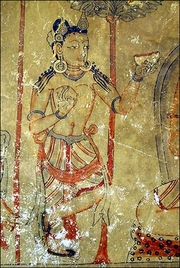
This undated photograph released by Sky Door Productions shows a panel from the Indian-influenced Newari art found on a mural in a newly discovered cave, estimated between the late 13th and 14th century, in northern Mustang. A team of explorers and scholars says it has found a cave in remote northern Nepal with a spectacular Buddhist mural unseen for centuries and discovered only because a shepherd took shelter there. Photo from AFP.
A team of explorers and scholars says it has found a cave in remote northern Nepal's Mustang region with a spectacular Buddhist mural unseen for centuries.
"Consisted by the archeologists and explorers from Nepal, Italy and America, our team was led by a local shepherd to the cave. He had sheltered in it decades earlier during a rainstorm," Prakash Darnal, chief archeologist of Nepal Cultural Protection and Development Bureau, told Xinhua News Agency on May 6.
55 paintings have been discovered in this cave. These 35-cm-wide and 43-cm-long drawings describe the stories of Buddha Sakyamuni. The main stunning seven-metre (23-foot) long mural can be dated back around the 14th century. The top of the cave is full of murals, Darnal says.
Some decorates used in these murals are very unique and the region is the only place in Asia with such pattern until now. The men in the murals are looked alike Indians while the letter patterns written in ink and bullion dope are doubted to be ancient Tibetan language.
"I haven't found that any literatures record this relic.So it's difficult to know the identity of the author,"Darnal says.
The local elders can remember the tales about these caves which have come down from the ancestors. According to them, long ago, each village had such a cave to study Buddhism and discuss official business.
"This is just a start. We have discovered some caves and there are forty to fifty stone rooms in one of them,"says Darnal.
The Mustang region, which opened to tourists in 1992, is 200 kilometers away from Katmandu, capital of Nepal with an altitude of 4,500 meter. Besides, the region is a visually stunning but often dry and harsh alpine terrain adjoining China's Tibet.
Thanks to the remote distance and rare human, the caves are protected well. Darnal rejects to release the detailed location of the caves to prevent robbers'peep.
Darnal is one of the two Nepalese experts. The team started to investigate the Mustang region since this March.
"I can unequivocally say that climbing into the caves was greatly more exciting than any emotions I had on Everest (Qomolangma),"said Athens, who has reached the top of the mountain seven times.
